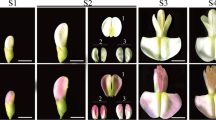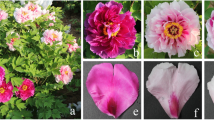Abstract
Dendrobium moniliforme is a native species of Korea. The flower of this species is composed of a reproductive column and white perianths including petals, sepals and lip, but the base of the column bears reddish purple pigment spots. Anthocyanins are major pigments that contribute flower color in Dendrobium. Three key anthocyanin biosynthetic genes encoding dihydroflavonol 4-reductase (DFR), chalcone synthase (CHS), and flavonoid 3',5'-hydroxylase (F3'5'H) were isolated and analyzed for their expression patterns in floral organs to understand the molecular mechanism underlying flower color development. Quantitative RT-PCR analysis revealed that F3'5'H transcripts were highly accumulated in the base of the column compared with those of perianths, but the other two genes showed no significant difference among the floral organs. Microprojectile bombardment using the white perianths revealed that the transient expression of F3'5'H gene, but not DFR and CHS genes, was sufficient to produce reddish purple colored pigmentation. These results suggest that the lack of colors in perianths of D. moniliforme is at least due to transcriptional control of F3'5'H. The data presented here may improve our understanding of the mechanisms underlying floral color development in D. moniliforme and contribute to advances in orchid biotechnology.






Similar content being viewed by others
Abbreviations
- RT-PCR:
-
Reverse transcription-polymerase chain reaction
- CHS:
-
Chalcone synthase
- DFR:
-
Dihydroflavonol 4-reductases
- F3'5'H:
-
Flavonoid 3',5'-hydroxylase
- F3'H:
-
Flavonoid 3'-hydroxylase
- F3H:
-
Flavanone 3-hydroxylase
- ANS:
-
Anthocyanidin synthase
- DHK:
-
Dihydrokaempferol
- DHQ:
-
Dihydroquercetin
- DHM:
-
Dihydromyricetin
References
Akashi R, Chie Y, Gondo T, Kawamura O, Hoffmann F (2002) Bialaphos-resistant cells of dallisgrass (Paspalum dilatatum Poir.) through particle bombardment with a simple self-built inflow gun. Grassland Sci 47:588–593
Arditti J, Fisch MH (1977) Anthocyanins of the Orchidaceae: distribution, heredity, functions, synthesis and localization. In: Arditti J (ed) Orchid biology: reviews and perspectives. Cornell University Press, Ithaca, pp 117–155
Baker ME, Blasco R (1992) Expansion of the mammalian 3 beta-hydroxysteroid dehydrogenase/plant dihydroflavonol reductase superfamily to include a bacterial cholesterol dehydrogenase, a bacterial UDP-galactose-4-epimerase, and open reading frames in vaccinia virus and fish lymphocystis disease virus. FEBS Lett 301:89–93
Beld M, Martin C, Huits H, Stuitje AR, Gerats AG (1989) Flavonoid synthesis in Petunia hybrida: partial characterization of dihydroflavonol-4-reductase genes. Plant Mol Biol 3:491–502
Broun P (2004) Transcription factors as tools for metabolic engineering in plants. Curr Opin Plant Biol 7:202–209
Chai D, Yu H (2007) Recent advances in transgenic orchid production. Orchid Sci Biotech 1:34–39
Chiou CY, Yeh KW (2008) Differential expression of MYB gene (OgMYB1) determines color patterning in floral tissue of Oncidium Gower Ramsey. Plant Mol Biol 66:379–388
Courtney-Gutterson N, Napoli C, Lemieux C, Morgan A, Firoozabady E, Robinson KE (1994) Modification of flower color in florist's chrysanthemum: production of a white-flowering variety through molecular genetics. Biotechnol NY 12:268–271
Dressler RL (1990) The orchids-natural history and classification. Harvard University Press, London
Epperson BK, Clegg MT (1987) Instability at a flower color locus in the morning glory. J Heredity 78:346–352
Forkmann G, Ruhnau B (1987) Distinct substrate specificity of dihydroflavonol 4-reductase from flowers of Petunia hybrida. Z Naturforsch 42C:1146–1148
Habu Y, Hisatomi Y, Iida S (1998) Molecular characterization of the mutable flaked allele for flower variegation in the common morning glory. Plant J 16:371–376
Hahlbrock H, Griesbach H (1975) Biosynthesis of flavonoids. In: Harborne JB, Mabry TJ, Mabry H (eds) The flavonoids. Academic, San Diego, pp 866–915
Han YY, Ming F, Wang W, Wang JW, Ye MM, Shen DL (2006) Molecular evolution and functional specialization of chalcone synthase superfamily from Phalaenopsis orchid. Genetica 128:429–438
Holton TA, Cornish EC (1995) Genetics and biochemistry of anthocyanin biosynthesis. Plant Cell 7:1071–1083
Holton TA, Tanaka Y (1994) Blue roses-A pigment of our imagination? Trends Biotechnol 12:40–42
Holton TA, Brugliera F, Lester DR, Tanaka Y, Hyland CD, Menting JG, Lu CY, Farcy E, Stevenson TW, Cornish EC (1993) Cloning and expression of cytochrome P450 genes controlling flower colour. Nature 366:276–279
Johnson ET, Yi H, Shin B, Oh BJ, Cheong H, Choi G (1999) Cymbidium hybrida dihydroflavonol 4-reductase does not efficiently reduce dihydrokaempferol to produce orange pelargonidin-type anthocyanins. Plant J 19:81–85
Johnson ET, Ryu S, Yi H, Shin B, Cheong H, Choi G (2001) Alteration of a single amino acid changes the substrate specificity of dihydroflavonol 4-reductase. Plant J 25:325–333
Johnson CS, Kolevski B, Smyth DR (2002) TRANSPARENT TESTA GLABRA2, a trichome and seed coat development gene of Arabidopsis, encodes a WRKY transcription factor. Plant Cell 14:1359–1375
Jorgensen RA, Cluster PD, English J, Que Q, Napoli CA (1996) Chalcone synthase cosuppression phenotypes in petunia flowers: comparison of sense vs. antisense constructs and single-copy vs. complex T-DNA sequences. Plant Mol Biol 31:957–973
Koes R, Verweij W, Quattrocchio F (2005) Flavonoids: a colourful model for the regulation and evolution of biochemical pathways. Trends Plant Sci 10:236–242
Kondo T, Yoshida K, Nakagawa A, Kawai T, Tamura H, Goto T (1992) Structural basis of blue-colour development in flower petals from Commelina communis. Nature 358:515–518
Koo J, Kim Y, Kim J, Yeom M, Lee IC, Nam HG (2007) A GUS/luciferase fusion reporter for plant gene trapping and for assay of promoter activity with luciferin-dependent control of the reporter protein stability. Plant Cell Physiol 48:1121–1131
Kubo H, Peeters AJ, Aarts MG, Pereira A, Koornneef M (1999) ANTHOCYANINLESS2, a homeobox gene affecting anthocyanin distribution and root development in Arabidopsis. Plant Cell 11:1217–1226
Lanz T, Tropf S, Marner FJ, Schröeder J, Schröeder G (1991) The role of cysteines in polyketide synthases. Site-directed mutagenesis of resveratrol and chalcone synthases, two key enzymes in different plant-specific pathways. J Biol Chem 266:9971–9976
Martin C, Gerats T (1993) Control of pigment biosynthesis genes during petal development. Plant Cell 5:1253–1264
Mudalige-Jayawickrama RG, Kuehnle AR (2006) Color genes in the orchid Oncidium Gower Ramsey: identification, expression, and potential genetic instability in an interspecific cross. Planta 223:521–531
Mudalige-Jayawickrama RG, Champagne MM, Hieber AD, Kuehnle AR (2005) Cloning and characterization of two anthocyanin biosynthetic genes from Dendrobium orchid. J Am Soc Hortic Sci 130:611–618
Nan GL, Kuehnle AR (1995) Genetic transformation in Dendrobium (Orchid). In: Bajaj YPS (ed) Biotechnology in agriculture and forestry, vol. 34, plant protoplasts and genetic engineering VI. Springer, New York, pp 149–160
Nesi N, Debeaujon I, Jond C, Stewart AJ, Jenkins GI, Caboche M, Lepiniec L (2002) The TRANSPARENT TESTA16 locus encodes the ARABIDOPSIS BSISTER MADS domain protein and is required for proper development and pigmentation of the seed coat. Plant Cell 14:2463–2479
Park JM, Whang SS, So SK, Lim PO, Lee HY, Koo JC (2010) Identification of differentially expressed genes in flower buds of Calanthe discolor and C. sieboldii. J Plant Biol 53:24–31
Pitakdantham W, Sutabutra T, Chiemsombat P, Pitaksutheepong C (2010) Isolation and characterization of chalcone synthase gene isolated from Dendrobium Sonia Earsakul. Pak J Biol Sci 13:1000–1005
Quattrocchio F, Wing J, van der Woude K, Souer E, de Vetten N, Mol J, Koes R (1999) Molecular analysis of the anthocyanin2 gene of petunia and its role in the evolution of flower color. Plant Cell 11:1433–1444
Reddy AR, Brltsch L, Salamlnl F, Saedler H, Rohde W (1987) The A1 (Anthocyanin-1) locus in Zea mays encodes dihydroquercetin reductase. Plant Sci 52:7–13
Sagasser M, Lu GH, Hahlbrock K, Weisshaar B (2002) A. thaliana TRANSPARENT TESTA 1 is involved in seed coat development and defines the WIP subfamily of plant zinc finger proteins. Genes Dev 16:138–149
Shiono M, Matsugaki N, Takeda K (2005) Structure of the blue cornflower pigment. Nature 436:791
Shoji K, Miki N, Nakajima N, Momonoi K, Kato C, Yoshida K (2007) Perianth bottom-specific blue color development in tulip cv. Murasakizuisho requires ferric ions. Plant Cell Physiol 48:243–251
Tanaka Y, Ohmiya A (2008) Seeing is believing: engineering anthocyanin and carotenoid biosynthetic pathways. Curr Opin Biotechnol 19:190–197
Tanaka Y, Tsuda S, Kusumi T (1998) Metabolic engineering to modify flower color. Plant Cell Physiol 39:1119–1126
van der Krol AR, Mur LA, Beld M, Mol JN, Stuitje AR (1990) Flavonoid genes in petunia: addition of a limited number of gene copies may lead to a suppression of gene expression. Plant Cell 2:291–299
Verdaguer B, de Kochko A, Beachy RN, Fauquet C (1996) Isolation and expression in transgenic tobacco and rice plants of the cassava vein mosaic virus (CVMV) promoter. Plant Mol Biol 31:1129–1139
Winkel-Shirley B (2001) Flavonoid biosynthesis. A colorful model for genetics, biochemistry, cell biology, and biotechnology. Plant Physiol 126:485–493
Wood HP (2006) The Dendrobiums. AR. G. Gantner Verlag, Ruggell
Yoshida K, Toyama-Kato Y, Kameda K, Kondo T (2003) Sepal color variation of Hydrangea macrophylla and vacuolar pH measurement with proton-selective microelectrode. Plant Cell Physiol 44:262–268
Yu H, Yang SH, Goh CJ (2001) Agrobacterium mediated transformation of Dendrobium orchid with the 1 knox gene DOH1. Plant Cell Rep 20:301–305
Acknowledgments
This work is supported by a grant (the development and conservation of useful plant resources of in and outside the country, 2010) run by Korea National Arboretum and the “Priority Research Centers Program through the National Research Foundation of Korea (NRF) funded by the Ministry of Education, Science and Technology (2009–0094060).”
Author information
Authors and Affiliations
Corresponding author
Rights and permissions
About this article
Cite this article
Whang, S.S., Um, W.S., Song, IJ. et al. Molecular Analysis of Anthocyanin Biosynthetic Genes and Control of Flower Coloration by Flavonoid 3′,5′-Hydroxylase (F3′5′H) in Dendrobium moniliforme . J. Plant Biol. 54, 209–218 (2011). https://doi.org/10.1007/s12374-011-9158-7
Received:
Revised:
Accepted:
Published:
Issue Date:
DOI: https://doi.org/10.1007/s12374-011-9158-7




